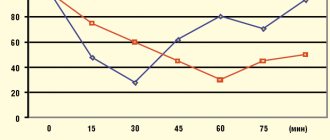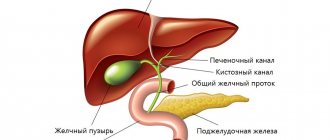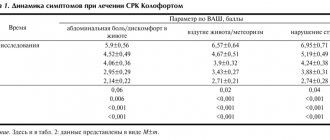Duspatalin relieves pain caused by spasms of the intestinal muscles. Helps speed up the treatment of irritable bowel syndrome, and also significantly reduces the risk of relapse. Having a pronounced antispasmodic effect, Duspatalin does not cause hypotension of the smooth muscles of the gastrointestinal tract.
general characteristics
Duspatalin is produced in Holland. You can purchase the drug in the form of tablets of 135 g and capsules of 200 mg. The capsule form contains a larger amount of the main active ingredient compared to tablets. Due to this, you can achieve a long-lasting effect from taking the drug. Therefore, on the packaging of capsules there is the word “retard”, which means “slow down” in English.
The capsules are covered with a dense gelatin-based shell; each capsule contains white granules. Markings on capsules: “245”, “S”, “7”. You can purchase packages containing 10, 20, 30, 50, 60 and 90 capsules.
The tablets are round in shape and white in color. They can be purchased in the same quantities as capsules, and also in packs of 15, 40, 100 and 120 pieces.
Regardless of the release form, the main active ingredient remains the same - mebeverine. However, the auxiliary components in capsules and tablets are different. Their comparative characteristics are presented in the table.
| Capsules | Pills |
| Talc | Starch |
| Magnesium stearate | Lactose monohydrate |
| Methyl methacrylate copolymer | Povidone K25 |
| Ethyl acrylate copolymer | Talc |
| Hypromellose | Magnesium stearate |
| Triacetin | Sucrose |
| Shellac | Gelatin |
| Gelatin | Acacia gum |
| Titanium dioxide | Brazilian wax |
| Iron oxide black | |
| Soy lecithin | |
| Defoamer |
Effect of taking
Taking Duspatalin allows you to relieve spasm from the smooth muscles of the digestive organs. This occurs by eliminating tension, which provokes pain. Since the intestines contain the most smooth muscles, the drug has the most pronounced effect on it. Elimination of hypertonicity occurs without affecting the peristalsis of the organ. Therefore, feces pass through the intestines without any slowdown. That is, Duspatalin has a targeted effect on the smooth muscles of the intestine, eliminating pain. At the same time, the sphincter of Oddi relaxes, which normalizes the flow of bile and provides an analgesic effect for biliary colic.
If the activity of intestinal smooth muscles is increased, then taking Duspatalin will bring it back to normal. However, the peristalsis of the organ will not be completely stopped, that is, its reflex hypotension will not occur.
After passing the drug through the organs of the digestive system, it enters the intestines, from where it is transported through the bloodstream to the liver. There, certain biochemical reactions are triggered, and the medicinal substance breaks down into metabolites. In this form, it is excreted from the body in urine. The main active substance is not released from the capsule as quickly as from tablets, so the therapeutic effect is extended for 16 hours. Moreover, for this it will be enough to take the drug once.
Duspatalin: what kind of medicine is it?
Duspatalin is an antispasmodic agent, the effect of which is mainly directed on the smooth muscles of the intestine. At the same time, there will be no effect on the normal functioning of the digestive organ, so the drug does not cause relaxation of the gastrointestinal tract tissues. In addition, Duspatalin has an anesthetic effect on the gastrointestinal tract.
The drug is taken for pain associated with intestinal dysfunction. Duspatalin acts symptomatically. That is, it does not treat the disease that caused the intestinal spasm, but only relieves the symptom - relaxes the smooth muscles where it is necessary, without affecting healthy areas of the intestine. This pain is especially typical during sudden attacks of diarrhea, when intestinal spasms and cramps interfere with a normal lifestyle. At the same time, Duspatalin can stop frequent and loose stools, reducing chaotic intestinal activity, which accelerates the process of movement of feces along its entire length.
When should Duspatalin be used?
Indications for taking the drug:
- Spasm-type pain localized in the epigastric region.
- Intestinal and biliary colic.
- Irritable bowel syndrome.
- Disturbances in the functioning of the gallbladder.
- Underwent surgery for resection of the gallbladder.
- Spasms of the smooth muscles of the digestive system against the background of pathologies of other organs (pain due to pancreatitis or cholecystitis).
- Pain caused by a functional disorder of the digestive system.
- Pain, discomfort and spasm in the intestines of a different etiology.
Instructions for use
Duspatalin in tablet form
The drug is not crushed before oral administration, washed down with plain water. You should take the medicine 30 minutes before meals.
It is permissible to take three tablets per day: in the morning, at lunchtime and in the evening. You should stop taking the drug after you feel better, that is, as soon as the pain stops.
The drug should not be discontinued abruptly. You must adhere to the following scheme:
- The first 7 days of withdrawal: take the drug 1 tablet in the morning and at lunch, and drink 1/2 tablet in the evening.
- From days 7 to 14, drink a whole tablet in the morning and evening.
- From days 14 to 21, take a whole tablet in the morning, and 1/2 of the drug in the evening.
- From days 21 to 28, take the drug 1 tablet in the morning.
According to this scheme, leading domestic clinicians who treat diseases of the digestive system suggest discontinuing the drug.
Depending on the specific case, the withdrawal regimen may be reviewed by the treating doctor. So, if after reducing the dose of the drug, the patient feels well, then it is possible to reduce the withdrawal regimen to 14 days. If the patient feels unsatisfactory when the dose is reduced by 1 tablet, then it should be reduced by 1/2 tablet. The patient's well-being should be monitored for at least 2 days.
Most experts recommend reducing the dosage by 1/2 tablet. If there is a need for faster withdrawal of the drug, then after 2 days you can again reduce the dosage by 1/2 tablet. Provided that the patient’s well-being does not deteriorate, this regimen should be continued until the end of the week (counting from the first day of dose reduction). If the patient begins to feel worse, then they switch to the classic scheme of stopping the drug. If the trend is positive, you can continue. That is, at the beginning of each subsequent week you will need to reduce the dose by 1/2 tablet, and after 2 days by another 1/2 tablet.
Abrupt withdrawal of the drug is unacceptable.
Duspatalin capsules
Do not chew the capsules, swallow them whole with plain water. The drug is taken 20 minutes before meals, 2 times a day.
The course of treatment is determined by the complete disappearance of pain and spasms. After this, you can begin to gradually reduce the dosage of the drug. Just like tablets, capsules should not be abandoned abruptly. The dosage should be reduced gradually. Drug withdrawal regimen:
- For the first 7-14 days, you need to take 1 capsule in the morning.
- After 7-14 days, you must stop taking the medicine.
To decide how long before you should stop taking the capsules - 7 or 14 days in advance, you need to take a two-day break after taking 1 capsule per day for a week. If during this time your health does not worsen, then you can completely refuse further treatment. Provided that the patient begins to feel worse, the course of therapy is extended for another 7 days, continuing to take 1 capsule in the morning. Then the drug is abandoned altogether.
Overdose
If a person takes too large a dose of the drug, this will lead to increased nervous excitability. To neutralize the effect of the drug, you should rinse your stomach and take activated charcoal orally. In the future, the patient is indicated for symptomatic treatment.
Concomitant use with other drugs
Duspatalin can be taken simultaneously with other medications.
It should be noted that Duspatalin can cause dizziness, so during the therapeutic course it is highly advisable to abandon activities that require increased concentration.
Material and methods
The study involved 68 patients aged 18 to 35 years with chronic noncalculous cholecystitis (NCC), who simultaneously showed various signs of biliary dysfunction. Violations of the motor-tonic function of the gastrointestinal tract were noted in 49 (72.1%) patients from the gallbladder and in 56 (82.3%) patients from the sphincter apparatus. In the structure of sphincter disorders in 27 (48.2%) of the examined individuals, hypertonicity of the sphincter of Oddi predominated. Other types of sphincter disorders occurred much less frequently: hypotonicity of the sphincter of Oddi - 9 (16.1%) cases, hypertonicity of the sphincter of Oddi - 10 (17.8%), hypotonicity - 7 (12.5%) and combined hypertonicity of the sphincter of Oddi and Lutkens - 3 (5.3%) cases. Motor-tonic disorders of the gallbladder were more often detected in the form of hypotonicity and hypokinesis of the gallbladder - 32 (65.3%) patients. Among the examined persons there were 41 (60.3%) women and 27 (39.7%) men. Patients who had taken other myotropic antispasmodics before the study were excluded from the study.
Depending on the therapy performed, two groups were formed by random sampling. The first included 34 patients who received DuspatalinR 200 mg 2 times a day 20 minutes before meals for 30 days as part of complex therapy (antibacterial therapy according to indications, choleretic agents, enzyme preparations, antacids). The second group consisted of 34 patients with CNC who received complex therapy for 30 days. These groups were comparable in age, gender and severity of changes in the VS. All patients signed informed consent to participate in the study.
The diagnosis in patients of both groups was verified using clinical, functional, laboratory and instrumental research methods. The diagnosis of “chronic non-calculous cholecystitis” was established in accordance with the classification of chronic cholecystitis (Ya.S. Zimmerman, 2002).
The main criteria for ultrasound diagnostics of CNC:
• thickening of the gallbladder wall (more than 3 mm) and an increase in its echogenic density (due to inflammatory edema and proliferation of fibrous tissue);
• presence of ultrasonographic Murphy's sign (pain at the GB point when pressed with an ultrasound probe);
• an increase in the size of the gallbladder by more than 5 cm from the upper limit of normal;
• the presence of a shadow from the walls of the gallbladder in the form of a “halo” around it, poor in echo signals.
The complex of studies included a clinical examination with an assessment of identified symptoms, a biochemical blood test, ultrasound of the abdominal organs, a scatological study, staged chromatic duodenal sounding (ECDS), carried out with graphic registration of bile secretion, microscopic and biochemical examination of the obtained bile fractions [5].
Statistical data analysis was carried out using standard software packages (Statistica, MS Excel) for personal computers. Comparison of two independent samples was carried out using the Student t-test for quantitative data with a normal distribution of indicator values or the Mann–Whitney U-test for ordinal and quantitative data with a non-normal distribution of indicator values. To assess the significance of differences in observation results between the two groups, the χ² test and Fisher test (absolute indicators) were used. Statistical hypotheses were tested at a critical level of p = 0.05.
The studies were carried out in accordance with the Declaration of Helsinki (approved by the institutional ethics committee).
Treatment of children with Duspatalin
Duspatalin is contraindicated for those under 12 years of age.
If the child is already 12 years old, the doctor may prescribe him Duspatalin to eliminate spasms and pain in the intestines and other organs of the digestive system.
Doctors recommend taking the drug for children with the following disorders:
- Heaviness and pain in the abdomen.
- Intestinal colic.
- Abdominal pain due to overeating.
- Abdominal pain caused by nervous tension.
- Irritable bowel syndrome in a child.
- Pain due to dietary errors. So, if a teenager suffers from abdominal pain due to a functional digestive disorder (the child ate a lot of baked goods, fast food or drank a lot of carbonated water), then he should immediately take a Duspatalin capsule. Another capsule is taken in the evening. The next day, treatment can be stopped, provided that your health has stabilized. If the child continues to feel unwell, the drug can be continued. When treatment is delayed for more than 7 days, the drug will need to be discontinued gradually, according to the scheme recommended for an adult.
So, only a doctor can prescribe courses of Duspatalin to a child. As a rule, this treatment regimen is rarely practiced. It is indicated for disturbances in the outflow of bile. Until the child's condition stabilizes, he will need to take two capsules of the drug per day. The withdrawal of the drug lasts for 10 days, during which time the child receives 1 capsule per day. Then they stop taking the medicine altogether.
Taking Duspatalin during pregnancy
Antispasmodics are prescribed during pregnancy with increased uterine tone. For this purpose, women are prescribed No-shpa. However, when a spasm passes to the smooth muscles of the intestines, it is better to use Duspatalin. With uterine hypertonicity, this drug will be ineffective.
Duspatalin should also be used during pregnancy if spasm of the sphincter of Oddi is observed. This leads to impaired bile flow and abdominal pain.
Studies have been conducted regarding the effects of Duspatalin on the fetus. During the experiments, it was possible to establish that the drug does not have a negative effect on the child in the womb. Therefore, if a doctor recommends taking a drug during pregnancy, then the benefits of its use outweigh all possible risks. Self-prescription of Duspatalin is unacceptable; consultation with a specialist is mandatory.
During pregnancy, you can only take capsules; tablets are strictly contraindicated during this period. You should not combine Duspatalin with other antispasmodics, for example, Papaverine or No-shpa.
The dose for pregnant women per day is 2 capsules. One of them is taken in the morning, and the second in the evening. The course of treatment continues until there is a noticeable improvement in well-being. The drug is discontinued gradually; for this purpose, drink 1 capsule per day for 14 days. After 14 days, the drug is completely stopped.
Duspatalin is often prescribed to women who, even before conceiving a child, suffered from spasms of the sphincter of Oddi. Often this condition accompanies chronic inflammation of the pancreas or occurs after surgery for resection of the gallbladder.
If a woman experiences a spasm of the smooth muscles of the intestine due to emotional stress, or as a result of errors in the diet, then you can take the medicine once. The cancellation scheme is not practiced in this case.
Results and discussion
According to the study, the main clinical manifestations of diseases of the biliary system in patients are expressed by dyspeptic and asthenovegetative syndromes. One of the main criteria for assessing the effectiveness of therapy for CNC and biliary tract dysfunction is the elimination of pain.
Among the subjects of the first group, all patients complained of pain before treatment. An assessment of the pain syndrome after a week of therapy with Duspatalin showed its complete disappearance in 44.2% of patients, in 55.8% the pain sensations decreased, their nature changed: the duration, intensity and frequency of pain decreased significantly. By the end of the course of treatment, the pain syndrome was relieved in all patients of the first group. In the second group, during examination, pain syndrome was also noted in all patients. During complex therapy, after seven days, pain completely disappeared in 17.6% of patients, in 44.1% there was a decrease in pain intensity, in 38.3% there was no change in the pain syndrome; by the end of the course of therapy, pain remained in 11.7% of patients. In the group of patients receiving basic therapy and DuspatalinR, dyspeptic syndrome was more often relieved: nausea, bitterness in the mouth, heartburn, flatulence, constipation. By the end of the course of treatment, dyspeptic symptoms persisted only in 8.8% of patients in the first group and in 14.7% in the second group. As a result of the relief of pain in patients using Duspatalin, the clinical manifestations of asthenovegetative syndrome were significantly more often eliminated, which by the end of the course of therapy was absent in 38.3% of patients, decreased in 52.9%, remained unchanged in 8.8%, and in the comparison group – in 20.5%, 52.9 and 26.6% of patients, respectively.
Studying the dynamics of data obtained during ECD is one of the conditions for studying the therapeutic effect of drugs used for diseases of the VVS. Changes in a number of ECD indicators were observed in patients before treatment. The same type of changes were revealed in both groups of patients in the form of a decrease in the time of closed sphincter of Oddi (phase II), an increase in the volumes of the ductal, cystic and hepatic phases of bile.
When analyzing the dynamics of dyskinetic disorders in patients of the first group, according to ECD data, a high percentage of normalization of indicators, improvement in the activity of the gallbladder and sphincter apparatus were noted. There were no patients with no positive dynamics. It follows that in patients receiving Duspatalin, relief of motor-tonic disorders was observed, regardless of their type. The use of Duspatalin in patients with chronic chronic cancer with hypokinesis of the gallbladder led to its normalization in 51.4%, and to improvement in 48.5%. With hypertonicity of the sphincter of Oddi, normalization of its activity was noted in 73.3%, improvement - in 26.6%, with hypertonicity of the sphincter of Lutkens - in 46.2 and 53.8%, respectively.
An analysis of the indicators of dysfunctional disorders of VHS revealed that in the first group of patients, treatment of patients with chronic chronic diseases using Duspatalin was more effective than the treatment of patients in the second group in all respects. In patients of the second group, with complex therapy, a positive effect, according to ECD data, was detected only in the restoration of the function of the sphincter of Oddi (phase II): time (minutes) 8.6 ± 0.3 and 5.3 ± 0.2 (p < 0. 05); 8.7 ± 0.4 and 6.2 ± 0.3. However, it was reliably insignificant; with hypertonicity of the sphincter of Oddi, normalization of its activity was noted only in 33.3%, and improvement in 66.7%.
Dysfunctional disorders of the gallbladder and biliary tract are one of the pathogenetic links in the development of cholelithiasis, therefore, reducing the lithogenicity of bile is an important condition for the prevention of cholelithiasis. In this regard, during the treatment process, the biochemical composition of bile in both groups was studied. In the first group of patients, during treatment with Duspatalin, positive dynamics of the main biochemical parameters of bladder and hepatic bile were noted. In the cystic portion of bile, there was a decrease in cholesterol levels (6.31 ± 0.27 and 3.84 ± 0.31 mmol/l), an increase in the level of cholic acid (14.9 ± 0.32 and 16.39 ± 1.28 mmol/l) and cholatecholesterol coefficient (2.32 ± 0.29 and 3.89 ± 0.37; p < 0.05) (Fig. 1). In the hepatic portion of bile there was also a decrease in cholesterol levels (3.35 ± 0.32 and 2.12 ± 0.27 mmol/l), an increase in the level of cholic acid (1.51 ± 0.12 and 2.92 ± 1.27 mmol/l; p < 0.05) and cholatecholesterol coefficient (0.71 ± 0.11 and 1.61 ± 0.79; p < 0.05).
After the treatment of patients of the second group, changes in the cholesterol content in the cystic and hepatic bile also took place (6.39 ± 0.16 and 5.64 ± 0.21 mmol/l; 2.65 ± 0.09 and 2.48 ± 0, 06 mmol/l, respectively), cholic acid (15.13 ± 0.21 and 15.89 ± 0.15 mmol/l; 1.35 ± 0.14 and 1.51 ± 0.13 mmol/l) and cholatecholesterol coefficient (2.41 ± 0.04 and 2.61 ± 0.02; 0.52 ± 0.14 and 0.66 ± 0.12), which were significantly insignificant (Fig. 2).
Consequently, complex treatment of patients with CNC using Duspatalin affects the lithogenic properties of cystic and hepatic bile.
Ultrasound was used to objectify the clinical effects of the drug DuspatalinR. As a result of the complex treatment, patients in both groups showed positive dynamics in ultrasound indicators. However, significantly more pronounced changes were obtained in the group of patients, in addition to the basic treatment who received DuspatalinR: reduction in the thickness of the gallbladder wall, normalization of the gallbladder volume, restoration of its motor-evacuation function (Table 1).
Note. Significant difference from the group before treatment: * p < 0.05; ** p < 0.01; *** p < 0.001. Chi Square (χ2) Test.
Thus, according to the literature and our own research, hypotension of the gastrointestinal tract with hypertonicity of the sphincter of Oddi is most common among the adult population. The results obtained from studying the clinical effectiveness of the drug DuspatalinR allow us to recommend it as the drug of choice, regardless of the type of dysfunctional disorders of the gastrointestinal tract and biliary tract. The use of Duspatalin makes it possible to cover a number of links in the pathogenesis of chronic cholecystitis: restore the biochemical composition of bile, correct motor-tonic disorders. The study showed good tolerability of the drug; no side effects were noted during treatment. The most appropriate is a course of use of the drug DuspatalinR for up to 30 days. In addition, taking into account the tendency to gallstone formation in this category of patients, it is necessary to correct dysfunctional disorders with the use of Duspatalin at least 2 times a year. Consequently, the clinical effectiveness of Duspatalin allows it to be recommended to patients in the complex treatment of biliary tract pathology.
Taking Duspatalin for pancreatitis
Duspatalin is an effective means of eliminating pain due to pancreatitis. This process is always accompanied by a violation of the outflow of pancreatic juice and spasm of the sphincter of Oddi. This problem can be solved by taking Duspatalin.
Due to inflammation of the pancreas, the excretory ducts become spasmodic, and juice is released in large quantities. As a result, the iron begins to digest itself with its own enzymes. To prevent this situation, it is necessary to expand the excretory ducts, relieving the spasm from them. It is Duspatalin that copes with this problem better than other antispasmodics.
The drug is prescribed for minor exacerbation of pancreatitis, which improves the patient’s well-being. For treatment, capsules are used, taking 1 capsule twice a day (morning and evening).
Treatment should continue until the patient's condition has stabilized. Then the drug is gradually withdrawn.
Duspatalin can also be used to prevent exacerbation of inflammation of the pancreas, provided that the disease is chronic. To do this, take 1 capsule 2 times a day for 14 days, and then take one capsule a day for another 7 days. In the future, the use of the drug is completely abandoned.
Is it possible to take Duspatalin for pancreatitis?
Pancreatitis is a disease of the pancreas in which the process of releasing enzymes into the duodenum, intended for the breakdown of fats and carbohydrates, is disrupted. Without coming into contact with food, and remaining in the body or ducts of the pancreas, enzymes begin to destroy the organ that produces them. Which leads to severe pain, in addition to the dangerous consequences of the release of decay products through the bloodstream into other organs.
The cause of impaired enzyme release may be dysfunction of the sphincter responsible for their release into the duodenum. Duspatalin, by relaxing the muscles of the tight sphincter, can facilitate the process of emptying the pancreas, which will improve the functioning of the gastrointestinal tract. In addition, the drug has an analgesic effect, which is very helpful for acute pain in the left hypochondrium.
Side effects of the drug
Side effects when taking the drug occur extremely rarely. A study was conducted involving 8 antispasmodics that are used to treat irritable bowel syndrome. During the experiment, it was possible to establish that Duspatalin, of all drugs, produces fewer side effects.
However, some patients may experience the following problems:
- Dizziness;
- Skin rashes;
- Quincke's edema and facial swelling;
- Allergy in the form of exanthema;
- Skin itching;
- Headache;
- Diarrhea or constipation;
- Nausea.
conclusions
In patients with pathology of the biliary tract, the use of Duspatalin leads to rapid relief of pain, dyspeptic and asthenovegetative syndromes.
The use of Duspatalin helps to correct motor-tonic disorders of the gallbladder, sphincter apparatus and normalize the physicochemical properties of bladder and hepatic bile.
The clinical effectiveness of Duspatalin, regardless of the type of dysfunction of the gallbladder and biliary tract, allows DuspatalinR to be considered the drug of choice at any stage of modern therapy for both therapeutic and prophylactic purposes.
Analogs
Russian pharmaceutical companies produce analogues and synonyms of the drug Duspatalin. Synonymous drugs contain mebeverine, while analogues have different components, but a similar therapeutic effect.
Drugs synonymous with Duspatalin:
- Niaspam in capsules.
- Sparex in capsules.
- Mebeverine in tablet form.
Duspatalin analogues:
- Trigan in the form of tablets and in the form of injections for intramuscular administration.
- Trimedat tablets.
- Spascuprel in tablets.
- Dibazol tablets.
- Buscopan tablets.
- Bendazole tablets.
- Dicetel in tablets.
- No-spa in tablets.
- Drotaverine tablets.
- Papaverine tablets.
Inexpensive analogues of Duspatalin
Duspatalin analog drugs for the treatment of irritable bowel syndrome at a lower price: Sparex, Trigan and Niaspam.
If we consider inexpensive antispasmodics, then these include: Drotaverine, No-shpa, Papaverine, Dicetel.
Reviews
Patients who received Duspatalin leave more positive reviews about it. They indicate that the drug allows you to quickly cope with intestinal and stomach colic, eliminate functional digestive disorders, and abdominal pain after overeating.
Patients with irritable bowel syndrome note that Duspatalin makes it possible to get rid of pain, regulate bowel movements, and reduce bloating. Patients receiving antibacterial treatment often suffer from dysbiosis, which causes severe abdominal pain. Duspatalin copes well with this problem. The pain begins to subside within half an hour after the first dose of the drug. Moreover, the capsules have a prolonged action.
Duspatalin has positive reviews from patients suffering from inflammation of the pancreas and gallbladder. The drug quickly relieves spasm, which leads to normalization of the patient's condition. Even with exacerbation of pancreatitis and cholecystitis, pain can be completely managed within 2-3 days. Patients with chronic pathologies take Duspatalin for preventive purposes and note its high effectiveness in preventing the development of relapses.
Negative reviews about Duspatalin are extremely rare. They boil down to the fact that the drug did not eliminate pain during exacerbation of inflammation of the pancreas or gall bladder. However, you should not expect a lightning-fast solution to the problem, since pain relief should take 2-3 days, not several hours. Therefore, such reviews can be considered not entirely justified.
Some people become disillusioned with the drug and take it inappropriately. Patients often indicate that Duspatalin did not help cope with gastritis or stomach ulcers. But this medicine is not intended to treat these diseases. Duspatalin is an antispasmodic and its main effect is to reduce pain.
Reviews from experts
Practicing gynecologists note that Duspatalin allows you to get rid of intestinal colic in pregnant women, regardless of the nature of their occurrence.
Therapists and gastroenterologists indicate that Duspatalin can be successfully used in the treatment of irritable bowel syndrome, pancreatitis, cholecystitis, as well as to get rid of negative symptoms that arise from functional digestive disorders.
Doctors indicate that Duspatalin cannot be used as a monocomponent for pancreatitis. The drug should be part of a complex therapy regimen. Otherwise, it will not be possible to achieve recovery.
Duspatalin in the treatment of functional diseases of the intestine and biliary tract
P
The first international classification of functional diseases of the gastrointestinal tract was presented at the XIII Gastroenterological Congress in 1988 in Rome.
It was then that the term irritable bowel syndrome was first officially approved and clinical criteria for its diagnosis were given. Irritable bowel syndrome (IBS) code K 58. according to the International Classification of Diseases (ICD X) - disorders of the motor and secretory function of the intestines, characterized by the presence of pain or abdominal discomfort for 12, not necessarily consecutive weeks over the last 12 months in combination with two of the following three signs: stop after defecation;
associated with changes in stool frequency; associated with changes in the shape of feces . This includes: IBS with diarrhea (code K 58.0), IBS without diarrhea (code K 58.9) and IBS with constipation (code K 59.0). Despite the heterogeneity of IBS, previous acute intestinal infections with the development of intestinal dysbiosis play a significant role in its occurrence.
And the greatest interest, especially in surgical clinics, is in conditions after cholecystectomy, accompanied by a violation of the functional state of the biliary tract. Over the past decades, the incidence of calculous cholecystitis has acquired a steady upward trend. Cholecystectomy has become the most common operation after appendectomy. More than 110 thousand operations are performed per year in Russia. According to various authors, 20–40% of patients who have undergone cholecystectomy still have complaints related to pain and dyspeptic disorders, which are usually regarded as postcholecystectomy syndrome: code K 91.5. according to the International Classification of Diseases (ICD X).
It should be noted that postcholecystectomy syndrome
is a collective concept that unites various pathological conditions and associated clinical manifestations observed in patients after removal of the gallbladder. Most authors who have studied this problem consider the term used to be not entirely successful. The term postcholecystectomy syndrome is currently used to designate dysfunction of the sphincter of Oddi (SDO) that develops after surgery, caused by a violation of the tone of the sphincter of the common bile duct, pancreatic duct or common sphincter, preventing the normal outflow of bile and pancreatic secretions into the duodenum in the obligatory absence of organic obstacles. In this regard, correct interpretation of pathophysiological disorders in the functioning of the sphincter apparatus of the biliary tract is important for making a diagnosis.
Despite intensive research and the search for new pharmacological groups of drugs for the treatment of irritable bowel syndrome and dysfunctional diseases of the biliary tract, the leading role in the treatment of abdominal pain in these diseases belongs to myotropic antispasmodics
. Numerous clinical studies have proven the effectiveness and good tolerability of myotropic antispasmodics for functional diseases of the intestine and biliary tract. However, the pharmacological group of myotropic antispasmodics is heterogeneous, and when choosing a drug, its mechanism of action should be taken into account, since abdominal pain is very often combined with other clinical symptoms, primarily flatulence, constipation and diarrhea.
Duspatalin (mebeverine hydrochloride) turned out to be the drug of choice in the treatment of these functional disorders.
. The main clinical advantage of Duspatalin is that it is indicated for patients with abdominal pain of functional origin, which is accompanied by both constipation and diarrhea, since the drug has a normalizing effect on intestinal function.
Mebeverine is a drug with an antispastic effect that has affinity for muscle tissue. It is used for the symptomatic treatment of abdominal pain, distress and discomfort associated with irritable bowel syndrome and sphincter of Oddi dysfunction. Mebeverine is also used to relieve spasms in various parts of the gastrointestinal tract due to its organic lesions.
The drug was first registered in 1965. Since then, it has been prescribed to (on average) 6.5 million patients per year worldwide. Mebeverine is currently sold in 74 countries under the trade names Colafac®, Duspatal®, Duspatalin®, Colospa®, Colotal® or Rudakol®.
It is widely recognized that double-blind, placebo-controlled clinical trials are absolutely essential when evaluating treatments for IBS and sphincter of Oddi dysfunction, given the high response rates to placebo (Cann, 1989). Over the past thirty-odd years, the effects of mebeverine have been studied in several double-blind, placebo-controlled clinical trials, including Connell (1965), Tasman-Jones (1973), Berthelot & Centonze (1981) and Prout (1983). The drug was also evaluated in comparison with standard drugs such as alverine citrate (Tudor, 1986), fenoverine (Salandre & Mignon, 1989) and dicycloverine (Grillage et al., 1990).
Mebeverine was statistically more effective than placebo in relieving abdominal pain and bowel dysfunction. Mebeverine has also proven effective in comparison with other antispastic agents.
Data on the safety and tolerability of the drug were obtained from clinical studies involving more than 3,500 patients taking mebeverine. The drug was always well tolerated by patients, even when using doses exceeding therapeutic ones. Most authors reported literally no side effects with treatment. The autonomic nervous system is not involved in the mechanism of action of mebeverine, therefore the drug in therapeutic doses does not have typical anticholinergic side effects. This makes it possible to use the drug in patients with concomitant diseases such as prostatic hypertrophy, urinary retention or glaucoma.
The most common drug in Russia is Duspatalin.
. A special feature of the drug is that smooth muscle contractions are not completely suppressed by mebeverine, which indicates the preservation of normal peristalsis after suppression of hypermotility. Indeed, there is no known dose of mebeverine that completely inhibits peristaltic movements, i.e. would cause hypotension.
Experimental studies show that mebeverine has two effects. First, the drug has an antispastic effect, reducing the permeability of smooth muscle cells to Na+. Secondly, it indirectly reduces the outflow of K+ and, accordingly, does not cause hypotension.
Contraction of smooth muscles of the gastrointestinal tract occurs when acetylcholine stimulates muscarinic receptors on the surface of the muscle cell. This causes sodium channels in the membrane to open, allowing Na+ to enter the cell. The resulting depolarization of the cell, in turn, promotes the opening of calcium channels and the entry of Ca2+ into the cell. The increased intracellular Ca2+ level leads to phosphorylation of myosin and, accordingly, to muscle contraction.
At therapeutic doses, mebeverine has a direct blocking effect on sodium channels, which limits the influx of Na+ and prevents the sequence of events leading to muscle spasm.
In addition to muscarinic receptors, smooth muscle cells in the wall of the gastrointestinal tract also have α1-adrenergic receptors associated with Ca2+ stores. This depot, located on the cell membrane, constantly restores the level of Ca2+ from the extracellular environment. Stimulation of the receptor by norepinephrine leads to the mobilization of Ca2+ from this depot into the intracellular space - a process that causes the opening of the channel for K+, which leads to hyperpolarization and decreased tone.
Mebeverine blocks the filling of the depot with extracellular Ca2+. Thus, if the a1-adrenergic receptor is activated in the presence of the drug, the depot is emptied, but cannot be filled again. Accordingly, the outflow of K+ is short-lived and permanent relaxation or hypotension does not occur.
Research into the effectiveness of Duspatalin in the treatment of functional bowel disorders has been conducted almost since its entry into the market. Data on the most authoritative studies are shown in Table 1.
The general conclusion of many authors after the study can be briefly summarized as follows: “The results obtained with mebeverine treatment are statistically significantly superior to the results obtained with placebo (p < 0.05)” (Tasman-Jones, 1973) or “In only 30 days, mebeverine resulted in to almost complete remission of abdominal pain and flatulence" (Secco et al., 1983). The results are presented in Figure 1.
Rice. 1. Evaluation of the effectiveness of mebeverine in the treatment of irritable bowel syndrome compared with placebo
The high effectiveness of mebeverine in the treatment of irritable bowel syndrome and sphincter of Oddia dysfunction has been noted in a number of other studies; the effectiveness of the drug in reducing pain and flatulence is presented in Figure 2.
Rice. 2. Efficacy of mebeverine in the treatment of IBS and sphincter of Oddi dysfunction
All research data on the effectiveness of mebeverine and comparing its effectiveness with placebo are statistically reliable, which proves
the need to choose Duspatalin for the treatment of spastic conditions and functional disorders of the gastrointestinal tract
.
A very important positive property of the drug is its low toxicity. Safety and tolerability data were obtained from clinical studies involving more than 3,500 patients treated with mebeverine.
In all studies, mebeverine was well tolerated by patients. Hematological and biochemical parameters remained unchanged throughout the course of treatment. Since the drug's introduction in 1965, no serious side effects have been reported. In an analysis of studies of drugs commonly used in the treatment of IBS and DSO, mebeverine ranked first in the absence of side effects (Poynard et al., 1994).
In most clinical studies of mebeverine, there was no mention of competitive symptoms occurring. This gives the drug a significant advantage over standard anticholinergic drugs, which, to obtain a therapeutic effect, must be prescribed in doses that act not only on the target organ, but also on other parts of the body.
Tasman-Jones (1973) noted that “the absence of anticholinergic properties is clearly an advantage; not only because the patient does not have unpleasant side effects, such as dry mouth, visual disturbances and constipation, but also because mebeverine is not contraindicated in patients with glaucoma and prostatic hypertrophy.”
Studies that used higher than standard doses also do not report a significant increase in side effects. Available data from the use of mebeverine at doses of 800 mg, 810 mg or 600 mg per day confirm that there were no clinically significant changes in safety parameters (Kastein, 1988; Van Outryve et al., 1996). Most patients tolerated these doses without experiencing noticeable side effects.
Thus, given the numerous studies on the use of mebeverine, some researchers suggest monotherapy with Duspatalin for such serious conditions as sphincter of Oddi dysfunction after cholecystectomy
(Ilchenko A.A., 2002). It was shown that after 2 weeks of Duspatalin therapy in patients who underwent cholecystectomy and have dysfunctional disorders of the sphincter apparatus of the biliary tract, there was a positive trend in pain relief, as well as normalization of both laboratory and ultrasound parameters.
The results obtained allow us to recommend Duspatalin to patients with various types of sphincter of Oddi dysfunction, both as monotherapy and in combination with other drugs. If necessary, it can be combined with antibacterial, enzyme preparations, as well as prokinetics. The undoubted advantage of the drug is the fact that it has a direct, almost selective antispastic effect on the smooth muscle tissue of the gastrointestinal tract. The exception is patients with organic lesions: choledocholithiasis; not eliminated or newly emerged stenosis of the large duodenal papilla and the distal part of the common bile duct.
A significant improvement in the condition is observed when treating irritable bowel syndrome with Duspatalin (Minushkin O.N., 2001), expressed in the disappearance or reduction of pain in patients by the 7th day of therapy. By day 14, pain was completely relieved in 60% of patients and significantly decreased in intensity and duration in 26.6% of patients. Abdominal bloating disappeared by day 7 of treatment. After 2 weeks, a clear trend toward normalization of stool frequency and consistency during diarrhea was noted. Heaviness in the right hypochondrium and discomfort in the epigastrium, noted in 16 patients, disappeared in 90% of patients.
After 2 weeks of treatment with Duspatalin, colon motility normalized in 50% of patients, and a tendency toward a decrease in increased motor activity appeared. In patients with diarrhea, the passage time through the gastrointestinal tract increased. The time of the carbolene test before treatment was 17.5 hours, after 2 weeks of treatment – 28.0 hours.
Thus, Duspatalin is a highly effective drug
in the treatment of irritable bowel syndrome and sphincter of Oddi dysfunction.
conclusions
1. The drug Duspatalin effectively relieves symptoms associated with impaired motor function of the intestines and biliary tract.
2. Duspatalin can be actively used to influence the main symptoms of functional disorders of the gastrointestinal tract, pain and spasm, flatulence, as a violation of the tone of the intestinal wall, and disturbances in the frequency and consistency of stool.
Literature:
1. Grigoriev P.Ya. Recommendations (protocols) for the diagnosis and treatment of patients with diseases of the digestive system. Practicing physician today. Gastroenterology series. 2002, No. 1, p. 3 – 34.
2. Dadvani S.A., Vetshev P.S., Shuludko A.M., “Cholelithiasis,” M., 2000, pp. 114–115.
3. Ilchenko A.A. Dysfunctional disorders of the biliary tract // Consilium medicum. (Appendix. Gastroenterology.) 2002. No. 1. pp. 20–23.
4. Kolesnikov L.L. Human sphincter apparatus. St. Petersburg, 2000. P. 99.
5. Minushkin O.N., Elizavetina G.A., Ardatskaya M.D. Treatment of functional disorders of the intestines and biliary system, occurring with abdominal pain and flatulence // Klin. Pharmacol. and ter. 2002. No. 1. P. 1–3.
6. Nozdrachev A.D., Bazhenov Yu.I., Barannikova I.A., Batuev A.S. – Beginnings of Physiology – St. Petersburg, Lan.2001.
7. Evans P., Bak., Kellow J. Mebeverine alters small bowel motility in irritable bowel syndrome // Aliment. Pharmacol. Ther. 1996. No. 10. R. 773.
What to choose: Duspatalin or Trimedat?
Trimedat and Duspatalin have a similar therapeutic effect, since both of these drugs relieve muscle spasm. The difference is that Trimedat has a wider spectrum of action compared to Duspatalin, so it is used to treat severe pathologies of the digestive system. If the patient has chronic pancreatitis or cholecystitis, or an exacerbation of the disease occurs, then Duspatalin can be taken.
In any case, the doctor must prescribe this or that drug, based on the individual characteristics of the patient’s body. Trimedat is more suitable for some patients, and Duspatalin for others.
What to choose: Duspatalin or Dicetel?
Dicetel has a less pronounced effect compared to Duspatalin. The drug will not completely relieve spasm from the ducts of the pancreas and gallbladder, which occurs against the background of inflammation of these organs. In addition, taking Dicetel is associated with a greater risk of developing allergic reactions than taking Duspatalin.
However, if a person has a digestive disorder caused by an irrational approach to nutrition, Dicetel can be used. In this case, the drug will cope well with the task of pain relief.








